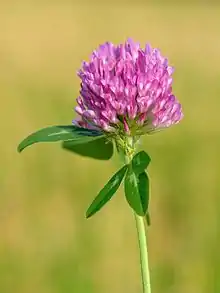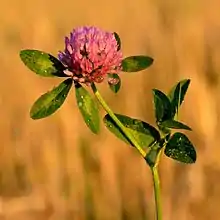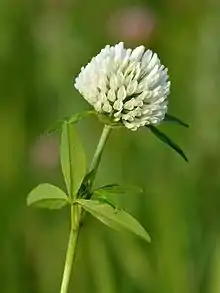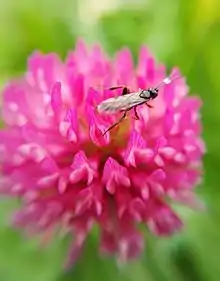Trifolium pratense
Trifolium pratense, the red clover,[1][2] is a herbaceous species of flowering plant in the bean family Fabaceae, native to Europe, Western Asia, and northwest Africa, but planted and naturalised in many other regions.
| Trifolium pratense | |
|---|---|
 | |
| Scientific classification | |
| Kingdom: | Plantae |
| Clade: | Tracheophytes |
| Clade: | Angiosperms |
| Clade: | Eudicots |
| Clade: | Rosids |
| Order: | Fabales |
| Family: | Fabaceae |
| Genus: | Trifolium |
| Species: | T. pratense |
| Binomial name | |
| Trifolium pratense | |
Description



Red clover is a herbaceous, short-lived perennial plant, variable in size, growing to 20–80 cm (8–31 in) tall. It has a deep taproot which makes it tolerant to drought and gives it a good soil structuring effect.[3] The leaves are alternate, trifoliate (with three leaflets), each leaflet 15–30 mm (0.6–1.2 in) long and 8–15 mm (0.3–0.6 in) broad, green with a characteristic pale crescent in the outer half of the leaf; the petiole is 1–4 cm (0.4–1.6 in) long, with two basal stipules that are abruptly narrowed to a bristle-like point. The flowers are dark pink with a paler base, 12–15 mm (0.5–0.6 in) long, produced in a dense inflorescence, and are mostly visited by bumblebees.[4]
Distribution
The red clover is native to Europe, Western Asia, and northwest Africa, but it has been naturalized in other continents, like North and South America. Specifically, the red clover was brought to Argentina and Chile over 100 years ago, although it is not clear how exactly it was introduced.[5] The red clover has become increasingly important as a source of economic stability in Chile, which has made the need for pollinators even more important.[6] One important pollinator, which was also brought from Europe, is Bombus ruderatus, or the large garden bumblebee. This bumblebee has been one of the important pollinators of red clover in South America and other countries such as New Zealand.[7]
Uses

It is widely grown as a fodder crop, valued for its nitrogen fixation, which increases soil fertility. For these reasons, it is used as a green manure crop. Several cultivar groups have been selected for agricultural use, mostly derived from T. pratense var. sativum. It has become naturalised in many temperate areas, including the Americas and Australasia as an escape from cultivation.
Due to its beauty, it is used as an ornamental plant.
Red clover's flowers and leaves are edible, and can be added as garnishes to any dish.[8] They can be ground into a flour.
The flowers often are used to make jelly and tisanes, and are used in essiac recipes. Their essential oil may be extracted and its unique scent used in aromatherapy.
Trifolium pratense's perennial nature affords sustained, reliable growth. Furthermore, the species' aforementioned value for nitrogen fixation promotes protein rich growth, thus able to support a wide range of wildlife including deer, turkeys, and rabbits. These characteristics make Trifolium pratense the ideal plant for hunters interested in utilizing botany as a method for attracting game.[9] The attractive pink flowers atop the stem afford high visibility levels and facilitate such attraction. Therefore, such species may similarly be used by wildlife remediation teams and conservationists seeking to build wildlife bridges in order to connect fragmented habitats. These species, native primarily to the American south,[10] provide strong attraction for deer, turkeys, and rabbit migration toward wildlife crossing, and therefore, away from roadways. [11]
Medical uses of the plant
Trifolium pratense is used in traditional medicine of India as deobstruent, antispasmodic, expectorant, sedative, anti-inflammatory and antidermatosis agent.[12]
In alternative medicine, red clover is promoted as a treatment for a variety of human maladies, including symptoms of menopause, coughs, disorders of the lymphatic system and a variety of cancers. Several systemic reviews and meta-analyses concluded that red clover extract reduces the frequency of menopause hot flashes. Most added that further research is needed to confirm the results.[13][14] There is no evidence in the human trial literature that red clover has been tested for effects on cough, lymphatic system or cancer prevention/treatment. Dietary amounts of red clover are safe, but dietary supplement extracts may cause rash-like reactions, muscle ache, headache, nausea, vaginal bleeding in women, and slow blood clotting.[15]
Red clover contains coumestrol, a phytoestrogen.[16] Due to its activity on oestrogen receptors, red clover is contraindicated in people with a history of breast cancer, endometriosis, ovarian cancer, uterine cancer, uterine fibroids or other oestrogen-sensitive conditions,[17] although some authors have suggested the high isoflavone content counteracts this, and even provides benefits in these conditions.[18] It is said to be a blood cleanser.
Due to its coumarin derivatives, T. pratense should be used with caution in individuals with coagulation disorders or currently undergoing anticoagulation therapy.[19]
It is metabolised by CYP3A4 and therefore caution should be used when taking it with other drugs using this metabolic pathway.[20]
Diseases
Red clover is subject to bacterial as well as fungal diseases, including the red clover rust, Uromyces trifolii-repentis var. fallens. Other problems include parasitic nematodes (roundworms) and viruses.
Symbolism
Trifolium pratense is the national flower of Denmark[21] and the state flower of Vermont.[22]
See also
- Green manure
- List of ineffective cancer treatments
References
- "BSBI List 2007". Botanical Society of Britain and Ireland. Archived from the original (xls) on 2015-01-25. Retrieved 2014-10-17.
- "Trifolium pratense". Natural Resources Conservation Service PLANTS Database. USDA. Retrieved 15 December 2015.
- "Red Clover". extension.psu.edu. Retrieved 2018-03-14.
- Van Der Kooi, C. J.; Pen, I.; Staal, M.; Stavenga, D. G.; Elzenga, J. T. M. (2015). "Competition for pollinators and intra-communal spectral dissimilarity of flowers". Plant Biology. 18 (1): 56–62. doi:10.1111/plb.12328. PMID 25754608.
- Rosso, B. S.; Pagano, E. M. (2005-08-01). "Evaluation of Introduced and Naturalised Populations of Red Clover(Trifolium pratense L.) at Pergamino EEA-INTA, Argentina". Genetic Resources and Crop Evolution. 52 (5): 507–511. doi:10.1007/s10722-005-0777-z. ISSN 0925-9864. S2CID 21172324.
- Arretz, P. V.; Macfarlane, R. P. (1986-01-01). "The Introduction of Bombus Ruderatus to Chile for Red Clover Pollination". Bee World. 67 (1): 15–22. doi:10.1080/0005772X.1986.11098855. ISSN 0005-772X.
- Morales, Carolina L; Arbetman, Marina P; Cameron, Sydney A; Aizen, Marcelo A (2013-07-15). "Rapid ecological replacement of a native bumble bee by invasive species". Frontiers in Ecology and the Environment. 11 (10): 529–534. doi:10.1890/120321. ISSN 1540-9295. S2CID 86469248.
- "Red Clover: Pictures, Flowers, Leaves and Identification | Trifolium pratense". www.ediblewildfood.com. Retrieved 2019-02-15.
- "Red Clover - Food Plot Seed | Pennington". Pennington.com. Retrieved 2021-01-22.
- "Red Clover - Food Plot Seed | Pennington". Pennington.com. Retrieved 2021-01-22.
- Society, National Geographic (2019-07-16). "Wildlife Crossings". National Geographic Society. Retrieved 2021-01-22.
- Indian medicinal plants : an illustrated dictionary. Khare, C. P., 1932-. Berlin: Springer. 2007. ISBN 9780387706375. OCLC 316267725.CS1 maint: others (link)
- Gartoulla P, Han MM (2014). "Red clover extract for alleviating hot flushes in postmenopausal women: a meta-analysis". Maturitas. 79 (1): 58–64. doi:10.1016/j.maturitas.2014.06.018. PMID 25074017.
- Ghazanfarpour M, Sadeghi R, Roudsari RL, Khorsand I, Khadivzadeh T, Muoio B (2016). "Red clover for treatment of hot flashes and menopausal symptoms: A systematic review and meta-analysis". J Obstet Gynaecol. 36 (3): 301–11. doi:10.3109/01443615.2015.1049249. PMID 26471215. S2CID 1987452.
- Red clover, WebMD.
- Bhagwat, Seema; Haytowitz, David; Holden, Joanne. "USDA Database for the Isoflavone Content of Selected Foods" (PDF). US Department of Agriculture. Retrieved 26 April 2015.
- Cornelia Bodinet & Johannes Freudenstein (2004). "Influence of marketed herbal menopause preparations on MCF-7 cell proliferation". Menopause. 11 (3): 281–289. doi:10.1097/01.gme.0000094209.15096.2b. PMID 15167307. S2CID 11117474.
- Dean W. Roberts, Daniel R. Doerge, Mona I. Churchwell, Gonçalo Gamboa da Costa, M. Matilde Marques & William H. Tolleson (2004). "Inhibition of extrahepatic human cytochromes P450 1A1 and 1B1 by metabolism of isoflavones found in Trifolium pratense (red clover)". Journal of Agricultural and Food Chemistry. 52 (21): 6623–6632. doi:10.1021/jf049418x. PMID 15479032.CS1 maint: multiple names: authors list (link)
- W. Abebe (2002). "Herbal medication: potential for adverse interactions with analgesic drugs". Journal of Clinical Pharmacy and Therapeutics. 27 (6): 391–401. doi:10.1046/j.1365-2710.2002.00444.x. PMID 12472978. S2CID 1828900.
- "Red clover (Trifolium pratense) Cautions - Epocrates Online". Online.epocrates.com. Retrieved 5 August 2012.
- "Other National Symbols". Embassy of Denmark, Washington DC. Archived from the original on 17 May 2007. Retrieved 3 April 2015.
- "Red Clover". Vermont Historical Society. Retrieved 3 April 2015.
Further reading
- Vleugels, Tim; Roldan-Ruiz, Isabel; Cnops, Gerda (April 8, 2014). "Influence of flower and flowering characteristics on seed yield in diploid and tetraploid red clover". Plant Breeding. 134 (1): 56–61. doi:10.1111/pbr.12224.
External links
| Wikimedia Commons has media related to Trifolium pratense. |
| Wikiversity has bloom time data for Trifolium pratense on the Bloom Clock |